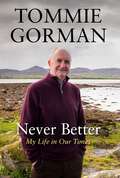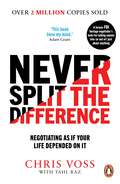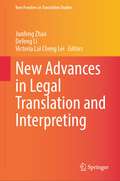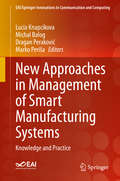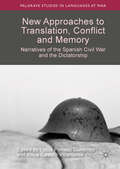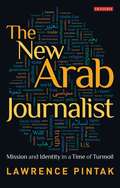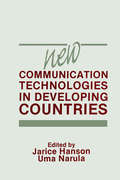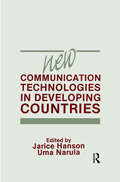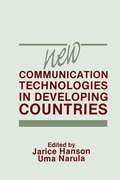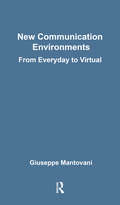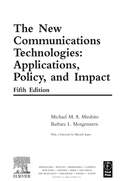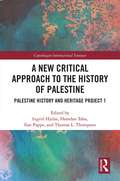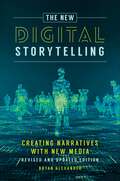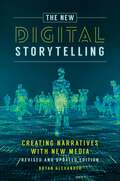- Table View
- List View
The Neutrality Trap: Disrupting and Connecting for Social Change
by Jacqueline N. Font-Guzmán, PhD, JD, MHA. Bernard S. MayerWork for social change through constructive engagement and systems disruption in this practical resource for social change advocates and conflict specialists In The Neutrality Trap, expert mediators and facilitators Bernard Mayer and Jacqueline N. Font-Guzmán deliver an insightful and practical exploration of how to understand the conflicts we face as social change agents. You'll learn about systems disruption and constructive engagement: how to develop the relationships and change strategies that help people, systems, and societies confront their most important social challenges. In this important book, you will: Discover how to challenge the status quo in an effective way Practice how to "get into good trouble," and pick the battles worth fighting Learn to be strategic in your approach to social change and sustain your efforts over the long term Perfect for anyone interested in progressing and achieving social justice, The Neutrality Trap is an indispensable guide to engaging in and managing the necessary conflict that comes with meaningful change.
The Neutrality Trap: Disrupting and Connecting for Social Change
by Bernard S. Mayer Jacqueline N. Font-Guzmán, PhD, JD, MHA.Work for social change through constructive engagement and systems disruption in this practical resource for social change advocates and conflict specialists In The Neutrality Trap, expert mediators and facilitators Bernard Mayer and Jacqueline N. Font-Guzmán deliver an insightful and practical exploration of how to understand the conflicts we face as social change agents. You'll learn about systems disruption and constructive engagement: how to develop the relationships and change strategies that help people, systems, and societies confront their most important social challenges. In this important book, you will: Discover how to challenge the status quo in an effective way Practice how to "get into good trouble," and pick the battles worth fighting Learn to be strategic in your approach to social change and sustain your efforts over the long term Perfect for anyone interested in progressing and achieving social justice, The Neutrality Trap is an indispensable guide to engaging in and managing the necessary conflict that comes with meaningful change.
Never Better: My Life in Our Times
by Tommie Gorman'Money is handy for doing messages' was a phrase the young Tommie Gorman heard from his father, growing up in Sligo in the 1960s. Struggle was never far away but their household had a surplus of love and warmth. From modest beginnings as a local reporter at the Western Journal, where his deadlines were dependent on the bus schedule, Tommie landed at RTÉ, taking up the post of North-West correspondent in 1980. Over the next four decades he became a familiar presence in Irish homes, known for his coverage of Europe and Northern Ireland, as well as his unforgettable interviews with controversial figures including Gerry Adams, Roy Keane, Ian Paisley and Arlene Foster. While revelling in his life as a journalist, he was also coping with the cancer diagnosis he received in 1994 and seeking ways to access life-saving treatments for patients who shared his rare form of the disease.In this insightful and generous book, Tommie takes readers behind the scenes and shares some of his memories from Sligo to Stormont, via Brussels and Sweden, as he recounts forty extraordinary years of Irish history from his front-row seat and looks at what may lie ahead for the island.
Never Had a Dad: Adventures in Fatherlessness
by null Georgie CoddFatherless, friendly 31yoF looking for intrepid M50s-70s who wants to try being a father figure (not sugar daddy). Georgie Codd never had a dad. And she didn’t think that would ever change – until a stranger’s practical joke made her wonder if she could find one. So began her quest for a father figure, placing ‘dadverts’ in newspapers, magazines and corners of the internet she thought the fatherly might frequent. Along with the conversations, meetings and the twists and turns of seeking family relationships with strangers comes a curious look at the societal, cultural and biological functions of fatherhood. What makes someone decide to have or not have a child? What is the experience for single parents, for queer communities, for people rejected by their birth family – or for those who do the rejecting? And why were so many ‘dads’ angling for something other than parenthood? By turns brilliant and bonkers, hilarious and poignant, this is an unexpected story of the strange, intimate things we mean when we talk about family.
Never Split the Difference: Negotiating as if Your Life Depended on It
by Tahl Raz Chris Voss'A master of persuasion.' Forbes'This book blew my mind.' Adam Grant, bestselling author of OriginalsA former FBI hostage negotiator offers a new, field-tested approach to negotiating – effective in any situation. After a stint policing the rough streets of Kansas City, Missouri, Chris Voss joined the FBI, where his career as a kidnapping negotiator brought him face-to-face with bank robbers, gang leaders and terrorists. Never Split the Difference takes you inside his world of high-stakes negotiations, revealing the nine key principles that helped Voss and his colleagues succeed when it mattered the most – when people’s lives were at stake. Rooted in the real-life experiences of an intelligence professional at the top of his game, Never Split the Difference will give you the competitive edge in any discussion.'Filled with insights that apply to everyday negotiations.' Business Insider'A stupendous book.' The Week'It's rare that a book is so gripping and entertaining while still being actionable and applicable.' Inc.
New Advances in Legal Translation and Interpreting (New Frontiers in Translation Studies)
by Junfeng Zhao Defeng Li Victoria Lai Cheng LeiThis book describes interdisciplinary exploration of matters related to the translation and interpreting of legal texts. Translation of legal texts has grown exponentially since the beginning of new millennium in response to the fast-increasing volume of international trade and business as well as all sorts of other transnational activities in a myriad of spheres. International trade demands translation of trade laws and business contracts, immigration leads to rise in court interpreting services, and countries may seek to enhance their international influence through translating and making known to the world their laws and/or other legal documents. These legal translation activities occurred mostly between languages officially used in international or regional organizations, such as the United Nations and the European Union, and between the languages of major countries who exert or seek influence on international economy and law. On the other hand, rapid advances in computer technology and artificial intelligence in recent years have also brought about changes in the practices of legal translation. With changes also come problems in both theory and practice that merit our immediate attention. This edited volume highlights the newest developments in the theory, practice, and training of legal translation, with contributions from international leading researchers in this area. It will be a standard reference for anyone who is to embark on research and practice of legal translation in the twenty-first century. It is also adaptable as teaching materials for translation and interpreting training.Chapter “Translating Legal Terms at International Organisations: Do Institutional Term Banks Meet Translators’ Needs?” is available open access under a Creative Commons Attribution 4.0 International License via link.springer.com.
New Advances in Translation Technology: Applications and Pedagogy (New Frontiers in Translation Studies)
by Defeng Li Yuhong Peng Huihui HuangFrom using machine learning to shave seconds off translations, to using natural language processing for accurate real-time translation services, this book covers all the aspects. The world of translation technology is ever-evolving, making the task of staying up to date with the most advanced methods a daunting yet rewarding undertaking. That is why we have edited this book—to provide readers with an up-to-date guide to the new advances in translation technology. In this book, readers can expect to find a comprehensive overview of all the latest developments in the field of translation technology. Not only that, the authors dive into the exciting possibilities of artificial intelligence in translation, exploring its potential to revolutionize the way languages are translated and understood. The authors also explore aspects of the teaching of translation technology. Teaching translation technology to students is essential in ensuring the future of this field. With advances in technology such as machine learning, natural language processing, and artificial intelligence, it is important to equip students with the skills to keep up with the latest developments in the field. This book is the definitive guide to translation technology and all of its associated potential. With chapters written by leading translation technology experts and thought leaders, this book is an essential point of reference for anyone looking to understand the breathtaking potential of translation technology.
A New Age of Reason: Harnessing the Power of Tech for Good
by Larry WeberLeverage technology to propel humankind toward a better future A New Age of Reason: Harnessing the Power of Tech for Good provides a roadmap for integrating emerging world-changing technologies, such as AI/robotics, chips/sensors, and quantum computing, to solve some of today’s thorniest and most pressing problems like climate change and world hunger. The author offers inspiring examples of companies using technology to positively impact humanity. The book provides an actionable playbook to transform your organization around this mission, including how to develop a tech for good strategy, how to evolve the C Suite to deliver on this mission, how to market it, as well as measure outcomes. The author also discusses the latest technology breakthroughs delivering positive world outcomes, such as: Extending a surgeon’s “eyes and hands” via robotics surgical systems to improve patient outcomes Computer vision tech that enables farmers to maximize crops to feed our burgeoning population AI/robotics that identify and fight wildfires Bringing together a collective of major thinkers on this subject and providing guidance for a better future, A New Age of Reason: Harnessing the Power of Tech for Good is a timely read for all executive leaders seeking to harness the new wave of technology to solve key societal problems and have a positive impact on the world.
A New Age of Reason: Harnessing the Power of Tech for Good
by Larry WeberLeverage technology to propel humankind toward a better future A New Age of Reason: Harnessing the Power of Tech for Good provides a roadmap for integrating emerging world-changing technologies, such as AI/robotics, chips/sensors, and quantum computing, to solve some of today’s thorniest and most pressing problems like climate change and world hunger. The author offers inspiring examples of companies using technology to positively impact humanity. The book provides an actionable playbook to transform your organization around this mission, including how to develop a tech for good strategy, how to evolve the C Suite to deliver on this mission, how to market it, as well as measure outcomes. The author also discusses the latest technology breakthroughs delivering positive world outcomes, such as: Extending a surgeon’s “eyes and hands” via robotics surgical systems to improve patient outcomes Computer vision tech that enables farmers to maximize crops to feed our burgeoning population AI/robotics that identify and fight wildfires Bringing together a collective of major thinkers on this subject and providing guidance for a better future, A New Age of Reason: Harnessing the Power of Tech for Good is a timely read for all executive leaders seeking to harness the new wave of technology to solve key societal problems and have a positive impact on the world.
New Approaches in Management of Smart Manufacturing Systems: Knowledge and Practice (EAI/Springer Innovations in Communication and Computing)
by Lucia Knapcikova Michal Balog Dragan Peraković Marko PerišaThis book provides a comprehensive and effective exchange of information on current developments in the management of manufacturing systems and Industry 4.0. The book aims to establish channels of communication and disseminate knowledge among professionals working in manufacturing and related institutions. In the book, researchers, academicians and practitioners in relevant fields share their knowledge from the sectors of management of manufacturing systems. The chapters were selected from several conferences in the field, with the topics including management of manufacturing systems with support for Industry 4.0, logistics and intelligent manufacturing systems and applications, cooperation management, and its effective applications. The book also includes case studies in logistics, RFID applications, and economic impacts in logistics, ICT support for industry 4.0, industrial and smart logistics, intelligent manufacturing systems and applications
New Approaches to Translation, Conflict and Memory: Narratives of the Spanish Civil War and the Dictatorship (Palgrave Studies in Languages at War)
by Lucía Pintado Gutiérrez Alicia Castillo VillanuevaThis interdisciplinary edited collection establishes a new dialogue between translation, conflict and memory studies focusing on fictional texts, reports from war zones and audiovisual representations of the Spanish Civil War and the Franco Dictatorship. It explores the significant role of translation in transmitting a recent past that continues to resonate within current debates on how to memorialize this inconclusive historical episode. The volume combines a detailed analysis of well-known authors such as Langston Hughes and John Dos Passos, with an investigation into the challenges found in translating novels such as The Group by Mary McCarthy (considered a threat to the policies established by the dictatorial regime), and includes more recent works such as El tiempo entre costuras by María Dueñas. Further, it examines the reception of the translations and whether the narratives cross over effectively in various contexts. In doing so it provides an analysis of the landscape of the Spanish conflict and dictatorship in translation that allows for an intergenerational and transcultural dialogue. It will appeal to students and scholars of translation, history, literature and cultural studies.
The New Arab Journalist: Mission and Identity in a Time of Turmoil (Library of Modern Middle East Studies #Vol. 85)
by Lawrence PintakThe Arab media is in the midst of a revolution that will inform questions of war and peace in the Middle East, political and societal reform, and relations between the West and the Arab World. Drawing on the first broad cross-border survey of Arab journalists, first-person interviews with scores of reporters and editors, and his three decades' experience reporting from the Middle East, Lawrence Pintak examines how Arab journalists see themselves and their mission at this critical time in the evolution of the Arab media. He explores how, in a diverse Arab media landscape expressing myriad opinions, journalists are still under siege as governments fight a rear-guard action to manage the message.This innovative book breaks through the stereotypes about Arab journalists to reveal the fascinating and complex reality - and what it means for the rest of us.
New Communication Technologies in Developing Countries (Routledge Communication Series)
by Jarice Hanson Uma NarulaThis volume explores how a number of developing countries -- including India, Malaysia, Columbia, Brazil, and Saudi Arabia -- are responding to the pressures of the information society. Infrastructural development, policies, and social systems are investigated, and models of information technologies and society are proposed in order to better reference the differences and similarities among the nations profiled. The authors identify the social technology perspective via the assimilation of technology in lifestyles and social systems. From this perspective, the diffusion of technologies is analyzed with a critical eye for theories of culture lag, diffusion and innovation, and technological determinism and liberalism. The social perspective is a new addition to development studies, and the reader may see how, as the global information society comes into focus, the social dimensions are more important than some theorists originally envisioned.
New Communication Technologies in Developing Countries: New Communication Technologies In Developing Countries (Routledge Communication Series)
by Jarice Hanson Uma NarulaThis volume explores how a number of developing countries -- including India, Malaysia, Columbia, Brazil, and Saudi Arabia -- are responding to the pressures of the information society. Infrastructural development, policies, and social systems are investigated, and models of information technologies and society are proposed in order to better reference the differences and similarities among the nations profiled. The authors identify the social technology perspective via the assimilation of technology in lifestyles and social systems. From this perspective, the diffusion of technologies is analyzed with a critical eye for theories of culture lag, diffusion and innovation, and technological determinism and liberalism. The social perspective is a new addition to development studies, and the reader may see how, as the global information society comes into focus, the social dimensions are more important than some theorists originally envisioned.
New Communication Technologies In Developing Countries (PDF)
by Jarice Hanson Uma NarulaThis volume explores how a number of developing countries -- including India, Malaysia, Columbia, Brazil, and Saudi Arabia -- are responding to the pressures of the information society. Infrastructural development, policies, and social systems are investigated, and models of information technologies and society are proposed in order to better reference the differences and similarities among the nations profiled. The authors identify the social technology perspective via the assimilation of technology in lifestyles and social systems. From this perspective, the diffusion of technologies is analyzed with a critical eye for theories of culture lag, diffusion and innovation, and technological determinism and liberalism. The social perspective is a new addition to development studies, and the reader may see how, as the global information society comes into focus, the social dimensions are more important than some theorists originally envisioned.
New Communications Environments: From Everyday To Virtual
by Giuseppe MantovaniThis multi-disciplinary book develops three intertwined themes: the perspective of situated action from cognitive science, a model of social context as a framework for inspiring artifact use and starting from it, and the individual and organizational impact of the new electronic environments of communication. Using plenty of up-to-date references from different scientific disciplines such as HCI, computer-mediated communication, cognitive sciences, social psychology, cultural anthropology and research in decision making, the book challenges older models of communication as information transfer and discusses the new communication environments.
New Communications Environments: From Everyday To Virtual
by Giuseppe MantovaniThis multi-disciplinary book develops three intertwined themes: the perspective of situated action from cognitive science, a model of social context as a framework for inspiring artifact use and starting from it, and the individual and organizational impact of the new electronic environments of communication. Using plenty of up-to-date references from different scientific disciplines such as HCI, computer-mediated communication, cognitive sciences, social psychology, cultural anthropology and research in decision making, the book challenges older models of communication as information transfer and discusses the new communication environments.
The New Communications Technologies: Applications, Policy, and Impact
by Michael Mirabito Barbara MorgensternAs new communications applications are developed and brought to market, it is vital for communications professionals to keep abreast of these issues. Since the technologies and applications also affect our daily lives, it is important to understand how they will shape the country and, by extension, the world at large. International censorship, the impact of the Internet and wireless tools, and th legisation following the World Trade Center bombing all fall into this category.The New Communications Technologies, Fifth Edition, provides vital information on the new and emerging technologies that will shape the way communicators do business. The book explores the new communications technologies and covers topics ranging from multimedia and production to satellites to digital communication. Just as important, the book examines the social, economic, and political impact brought about by the adoption of such technologies and applications; this fallout includes privacy concerns, First Amendment issues, and the implications raised by biometric systems.
The New Communications Technologies: Applications, Policy, and Impact
by Michael Mirabito Barbara MorgensternAs new communications applications are developed and brought to market, it is vital for communications professionals to keep abreast of these issues. Since the technologies and applications also affect our daily lives, it is important to understand how they will shape the country and, by extension, the world at large. International censorship, the impact of the Internet and wireless tools, and th legisation following the World Trade Center bombing all fall into this category.The New Communications Technologies, Fifth Edition, provides vital information on the new and emerging technologies that will shape the way communicators do business. The book explores the new communications technologies and covers topics ranging from multimedia and production to satellites to digital communication. Just as important, the book examines the social, economic, and political impact brought about by the adoption of such technologies and applications; this fallout includes privacy concerns, First Amendment issues, and the implications raised by biometric systems.
New Connectivities in China: Virtual, Actual and Local Interactions
by Pui-Lam LawThe fast diffusion of information and communication technologies (ICTs) in China has brought forth new forms of connection among the Chinese and has changed their social lives. Virtual networks have been developed and in turn have led to the formation of networks in the actual world. This collection explores the resultant complications in the relationship between virtual, actual, and local interactions. It discusses various aspects of the implications of the new connectivities on these three types of interactions in China. The topics examined include: the possibility of the development of civil society in China, the implications for the migrant workers in the south, the challenge posed to the traditional social order, and the relationship between the new connectivities and the Chinese social context.
A New Critical Approach to the History of Palestine: Palestine History and Heritage Project 1
by Ingrid Hjelm Hamdan Taha Ilan Pappe Thomas L. ThompsonA New Critical Approach to the History of Palestine discusses prospects and methods for a comprehensive, evidence-based history of Palestine with a critical use of recent historical, archaeological and anthropological methods. This history is not an exclusive history but one that is ethnically and culturally inclusive, a history of and for all peoples who have lived in Palestine. After an introductory essay offering a strategy for creating coherence and continuity from the earliest beginnings to the present, the volume presents twenty articles from twenty-two contributors, fifteen of whom are of Middle Eastern origin or relation. Split thematically into four parts, the volume discusses ideology, national identity and chronology in various historiographies of Palestine, and the legacy of memory and oral history; the transient character of ethnicity in Palestine and questions regarding the ethical responsibilities of archaeologists and historians to protect the multi-ethnic cultural heritage of Palestine; landscape and memory, and the values of community archaeology and bio-archaeology; and an exploration of the “ideology of the land” and its influence on Palestine’s history and heritage. The first in a series of books under the auspices of the Palestine History and Heritage Project (PaHH), the volume offers a challenging new departure for writing the history of Palestine and Israel throughout the ages. A New Critical Approach to the History of Palestine explores the diverse history of the region against the backdrop of twentieth-century scholarly construction of the history of Palestine as a history of a Jewish homeland with roots in an ancient, biblical Israel and examines the implications of this ancient and recent history for archaeology and cultural heritage. The book offers a fascinating new perspective for students and academics in the fields of anthropological, political, cultural and biblical history.
A New Critical Approach to the History of Palestine: Palestine History and Heritage Project 1
by Ingrid Hjelm Hamdan Taha Ilan Pappe Thomas L. ThompsonA New Critical Approach to the History of Palestine discusses prospects and methods for a comprehensive, evidence-based history of Palestine with a critical use of recent historical, archaeological and anthropological methods. This history is not an exclusive history but one that is ethnically and culturally inclusive, a history of and for all peoples who have lived in Palestine. After an introductory essay offering a strategy for creating coherence and continuity from the earliest beginnings to the present, the volume presents twenty articles from twenty-two contributors, fifteen of whom are of Middle Eastern origin or relation. Split thematically into four parts, the volume discusses ideology, national identity and chronology in various historiographies of Palestine, and the legacy of memory and oral history; the transient character of ethnicity in Palestine and questions regarding the ethical responsibilities of archaeologists and historians to protect the multi-ethnic cultural heritage of Palestine; landscape and memory, and the values of community archaeology and bio-archaeology; and an exploration of the “ideology of the land” and its influence on Palestine’s history and heritage. The first in a series of books under the auspices of the Palestine History and Heritage Project (PaHH), the volume offers a challenging new departure for writing the history of Palestine and Israel throughout the ages. A New Critical Approach to the History of Palestine explores the diverse history of the region against the backdrop of twentieth-century scholarly construction of the history of Palestine as a history of a Jewish homeland with roots in an ancient, biblical Israel and examines the implications of this ancient and recent history for archaeology and cultural heritage. The book offers a fascinating new perspective for students and academics in the fields of anthropological, political, cultural and biblical history.
New Developments of IT, IoT and ICT Applied to Agriculture: Proceedings of ICAIT 2019 (Smart Innovation, Systems and Technologies #183)
by Kazumi Nakamatsu Roumen Kountchev Ari Aharari Nashwa El-Bendary Bin HuThe proceedings publishes new research results of scholars from the First International Conference on Agriculture and Information (ICAIT2019) organized by IRNet International Academic Communication Center, held during November 22-24, 2019. The book covers works from active researchers who are working on collaboration of agriculture and various information technologies such as ICT (Information and Communication Technologies) applicable/applied to agricultural produce, manufacturing preservation and distribution of agricultural products, etc. The book focuses on theory, design, development, testing and evaluation of all information technologies applicable/applied to various parts of agriculture and its infrastructure. The topics included are information technologies applicable to smart agriculture, intelligent information systems for smart farm systems, web-based intelligent information systems on agriculture, ICT-based marketing of agricultural products, agricultural product consumption network systems, IoT for agricultural produce and products, soft computing theories, intelligent management for agriculture, data science techniques for agriculture.
The New Digital Storytelling: Creating Narratives with New Media--Revised and Updated Edition
by Bryan AlexanderNewly revised and updated, this is the essential guide to state-of-the-art digital storytelling for audiences, creators, and teachers.Written for everyone interested in the communication potential of digital media, including educators, marketers, communication professionals, and community activists, this is the ultimate guide to harnessing technology for storytelling. No other book covers the digital storytelling movement as thoroughly as this updated second edition of a popular work, nor does any incorporate as many technologies, from video to augmented reality, mobile devices to virtual reality.The book combines history, analysis, and practical guidance about digital storytelling. It begins with a history that encompasses an exploration of storytelling itself, as well as a description of narratives using digital tools from the 1980s through 2000. From there, the author dives into modern digital storytelling, offering analysis and guidance regarding the use of digital video, podcasting, social media, gaming, mobile devices, and virtual and augmented reality. The work concludes with practical advice about how to create and share digital stories using the most current tools so even the new would-be storyteller can create their first digital narrative. Of course, the second edition is updated to take into account the many ways the field has advanced since the original book appeared. With many new examples of digital stories, this edition's evidence base is current and fresh. New or transformed technologies are also addressed, including virtual reality; mobile devices that have become mainstream tools for creating, sharing, and experiencing digital stories; and the wide variety of new storytelling apps and services.
The New Digital Storytelling: Creating Narratives with New Media--Revised and Updated Edition
by Bryan AlexanderNewly revised and updated, this is the essential guide to state-of-the-art digital storytelling for audiences, creators, and teachers.Written for everyone interested in the communication potential of digital media, including educators, marketers, communication professionals, and community activists, this is the ultimate guide to harnessing technology for storytelling. No other book covers the digital storytelling movement as thoroughly as this updated second edition of a popular work, nor does any incorporate as many technologies, from video to augmented reality, mobile devices to virtual reality.The book combines history, analysis, and practical guidance about digital storytelling. It begins with a history that encompasses an exploration of storytelling itself, as well as a description of narratives using digital tools from the 1980s through 2000. From there, the author dives into modern digital storytelling, offering analysis and guidance regarding the use of digital video, podcasting, social media, gaming, mobile devices, and virtual and augmented reality. The work concludes with practical advice about how to create and share digital stories using the most current tools so even the new would-be storyteller can create their first digital narrative. Of course, the second edition is updated to take into account the many ways the field has advanced since the original book appeared. With many new examples of digital stories, this edition's evidence base is current and fresh. New or transformed technologies are also addressed, including virtual reality; mobile devices that have become mainstream tools for creating, sharing, and experiencing digital stories; and the wide variety of new storytelling apps and services.

